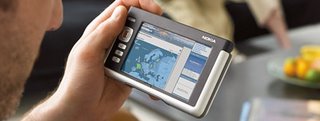
Before I get into it, here are the highlights.
- Weight: 8.1 Ounces
- Size: 5.5 x 3.1 x 0.7 inches
- Display: 800x480 touch screen with 65,536 colours
- Memory: 128 MB Flash (holds a RS-MMC expansion card)
- Networking: 802.11 b/g WLAN, Bluetooth, USB 2.0
To start, the tablet feels well made, heavy for its size and not delicate in the least. It has a hard shell that slides off exposing the screen and the buttons on the left. The stylus is hidden in behind and is easily retrieved (if you are right handed). The screen has good resolution and you can control the brightness setting (which will help with battery life). It is a little big for your back pocket, but it will easily fit into your shirt sleeve or backpack side pocket. I hated the 128 MB memory limitation and purchased a 2 GB RS-MMC card which gives me more virtual memory and a location for new applications and documents - now I have space to put that movie that I may want to watch. Battery life is outstanding - the Nokia site gives 3 hours of browsing as the average, I've pushed this to 5. Maybe I've just gotten lucky, but I doubt it as I've never had good luck with batteries. When I put the device on standby, it comes right up with plenty of juice to spare.
The connectivity is very good. WLAN supports WPA2 and you can surf at any public wireless location. Getting connected is easy - with a small icon on the top right telling you if you are connected or not - and if not, simply click on it to search for all the exposed wireless locations near you. And if at home, you can save your favourite connections and they will start whenever you open an application that needs network access. I installed Aircrack-ng just to see what type of things I could do - this device is fully functional I assure you.
Using the applications that came with the device - surfing, email, instant messaging, RSS reader and a couple multimedia applications - I found all were more than acceptable, but not outstanding. I suspect this has more to do with the low memory footprint than the choices Nokia had installed. No worries, it has a friendly means to add more software. But the good thing is, since the device is Open Source it is possible to get a large number of applications for the device, or if you have some time, compile them yourself. For example, I installed osso-xterm so I could drop to shell and see what the device had on it - this is just your basic Linux distribution under the slick outer shell people.
The responsiveness of the tablet is poor - it can barely do more than two user applications at a time and if you use more, the responsiveness is somewhere between frustrating to infuriating. Using a single application is fine - even when that application is large like FreeCiv, which has a port for the Nokia 770 available.
After a month of playing with this device, I am unsure how to best utilize it. I mean I have a Linux laptop that goes everywhere I do - do I really need another device. And if I did, it better have something my laptop lacks - which the Nokia 770 doesn't. I read the reviews before purchasing and will have to agree to the medium grade that was given. There is no doubting the coolness factor in the tablet but I just don't see myself pulling it out enough to warrant the price.

No comments:
Post a Comment